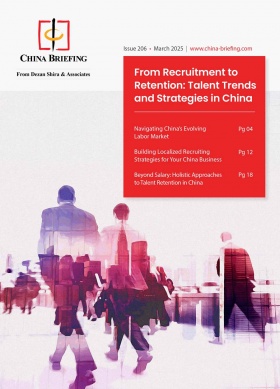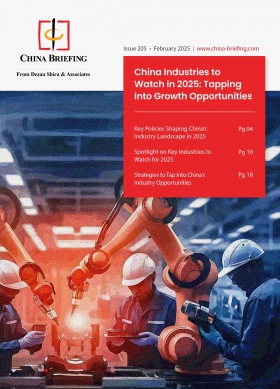China’s Economy Beats Expectations in Q1 2025 – Can Momentum Last?
China’s economy posted stronger-than-expected growth in Q1 2025, with GDP expanding 5.4 percent year-on-year — outperforming forecasts thanks to a surge in exports. However, analysts warn that this momentum may be difficult to sustain as escalating tariffs from the US cast a long shadow over global trade flows.
China’s economy began 2025 on a stronger footing than many had anticipated, defying global headwinds and domestic challenges. According to data released by the National Bureau of Statistics on April 16, China’s gross domestic product (GDP) reached RMB 31.88 trillion (US$4.40 trillion) in the first quarter — marking a 5.4 percent year-on-year increase in real terms. This performance exceeded market expectations, beating both the 5.1 percent growth forecast in Caixin’s economist survey and the estimate from a Reuters poll.
Behind this headline figure, a surge in foreign trade stood out as a major contributor to the economy’s early-year strength. Export growth in particular provided a strong boost, expanding by 6.9 percent year-on-year in yuan terms during the first quarter. March alone saw an eye-catching 13.5 percent jump in exports, underlining the critical role that trade played in lifting the growth rate above expectations.
However, analysts caution against viewing this momentum as a long-term trend. Much of the export strength is believed to be driven by a “pre-tariff rush,” as Chinese exporters accelerated shipments ahead of the steep tariff hikes recently announced by the United States. This front-loading effect raises questions about the sustainability of China’s trade-driven growth in the months to come.
In this article, we take a closer look at China’s key economic indicators for the first quarter of 2025, assess the durability of its foreign trade momentum, and highlight the policy measures and global risks that will shape the outlook for the rest of the year.
China’s economy in Q1 2025 – key indicators
China’s economy continued its recovery momentum in the first quarter of 2025, with strong overall growth led by manufacturing and high-tech industries. Business confidence remained resilient, as evidenced by solid gains in fixed asset investment across key sectors. Meanwhile, retail sales posted a healthy expansion, supported by policy incentives and rebounding activity. However, underlying consumption trends remained cautious, with deflationary pressures weighing on consumer prices and signaling subdued household demand.
All three primary sectors saw robust growth in the first quarter:
- The primary sector grew by 3.5 percent to reach RMB 1.17 trillion (US$159.4 billion);
- The secondary sector grew 5.9 percent to reach RMB 11.2 trillion (US$1.5 trillion); and
- The tertiary sector grew 5.3 percent to reach RMB 19.5 trillion (US$2.7 trillion).
China’s urban surveyed unemployment rate remained stable, reaching 5.3 percent in the first quarter. This is a slight increase of 0.1 percentage points compared to the first quarter in 2024. In March, however, the unemployment rate was 5.2 percent, a drop of 0.2 percentage points from the previous month.
Incomes also continued to grow. In the first quarter, the average disposable income per capital reached RMB 12,179 (US$1,657) up 5.5 percent in nominal terms from the previous year (when removing price factors, the growth rate reached 5.6 percent year-on-year).
Manufacturing
The value-added output of industrial enterprises above the designated size (those with an annual main business income of above RMB 20 million (US$2.7 million)), grew by 6.5 percent, an acceleration of 0.7 percent from the annual growth rate in 2024. The manufacturing sector saw a 7.1 percent expansion from the previous year, of which:
- Value-added output of the equipment manufacturing grew 10.9 percent year-on-year;
- Value-added output of the high-tech manufacturing industry grew 9.7 percent year-on-year.
In March, the Manufacturing Purchasing Managers’ Index (PMI), an index that weighs new orders, production, employees, supplier delivery time, and raw material inventory in the industry, increased by 0.3 percentage points to 50.5 percent, indicating an expansion.
Services
The services sector saw similarly strong growth, with the value-added output increasing by 5.3 percent year-on-year, 0.3 percentage points faster than the annual rate in 2024. Of this:
- The value-added output of the information transmission, software, and IT services industry grew by 10.3 percent year-on-year;
- The value-added output of the leasing and business services industry grew by 10.2 percent year-on-year;
- The value-added output of the transport, warehousing, and postal services industry grew by 7.2 percent year-on-year;
- The value-added output of the retail and wholesale industry grew by 5.8 percent year-on-year; and
- The value-added output of the hospitality and catering industry grew by 5.1 percent year-on-year.
Consumption and retail sales
Retail sales posted healthy growth in the first quarter, despite underlying demand issues. In March, the retail sales increased 7.7 percent, the fastest growth since December 2023.
Total retail sales of social and consumer goods were valued at RMB 12.5 trillion (US$1.7 trillion), up 4.6 percent from the same period in 2024. This is an acceleration of 1.1 percentage points from the annual rate in 2024. Online retail sales, meanwhile, reached RMB 3.6 trillion (US$493.2 billion), an increase of 7.9 percent from the same period in 2024.
Breaking down the retail sales:
- Merchandise sales reached RMB 11.1 trillion (US$1.5 trillion) up 4.6 percent year-on-year; and
- F&B income reached RMB 1.4 trillion (US$190.9 billion) up 4.7 percent year-on-year.
China’s “old-for-new” initiative, in which fiscal subsidies are provided to encourage consumers to upgrade large articles (such as cars, white goods, and furniture), also continued to bear fruit, with significant increases in the sales of communication equipment (up 26.9 percent year-on-year), cultural and office supplies (up 21.7 percent year-on-year), household appliances and audio-visual equipment (up 19.3 percent year-on-year), and furniture (up 18.1 percent year-on-year).
Despite an uptick in retail sales, overall consumption remained sluggish, with deflationary pressures continuing to suppress consumer prices, in particular food and energy. CPI in the first quarter fell by 0.1 percent year-on-year; however, when removing food and energy prices, CPI increased by 0.3 percent year-on-year.
Fixed asset investment
Healthy spending on physical assets in the first quarter indicates continued confidence in the economy, as companies continue to expand investment. Fixed asset investment (FAI) in the first quarter reached RMB 10.3 trillion (US$1.4 trillion), an increase of 4.2 percent from the same period last year.
However, the persistent slump in the property market continued to depress FAI in the first quarter. The sales area of newly built commercial property fell by 3 percent year-on-year, a deceleration of 2.1 percentage points from the January to February period.
Breaking down by major sectors:
- Infrastructure investment grew by 5.8 percent year-on-year;
- FAI in manufacturing increased 9.1 percent year-on-year; and
- Real estate development investment fell by 9.9 percent year-on-year.
FAI in the high-tech industries remained strong, indicating continued optimism in this high-growth segment. Overall FAI in the high-tech sector grew by 6.5 percent year-on-year, with particularly high growth rates recorded in information services (34.4 percent year-on-year), aerospace and equipment manufacturing (30.3 percent), computers and office equipment manufacturing (28.5 percent year-on-year) and professional technology services (26.1 percent year-on-year).
However, the uptick in FAI was overwhelmingly driven by public companies. FAI among state-owned enterprises grew by 6.5 percent year-on-year, while the average growth rate among private companies was only 0.4 percent.
Breaking down further, we can see that foreign-invested enterprises (FIEs) continued to reduce their investments in the first quarter, with FAI dropping 9.5 percent year-on-year. This is compared to a 4 percent increase among domestic private companies and a 10.8 percent increase among Hong Kong, Taiwan, and Macao-backed enterprises.
Foreign trade
China’s overall foreign trade experienced modest growth in the first quarter of 2025, with the growth rate significantly impacted by falling imports. Total imports and exports grew by 1.3 percent from the first quarter of 2024, reaching RMB 10.3 trillion (US$1.4 trillion). Of this, exports grew by 6.9 percent year-on-year to RMB 6.1 trillion (US$834.4 billion), and imports fell by 6 percent to RMB 4.2 trillion (US$567.5 billion), reflecting weak domestic demand.
In March, total two-way trade reached RMB 3.8 trillion (US$512.5 billion), up 6 percent year-on-year, of which exports grew by 13.5 percent to RMB 2.3 trillion (US$306.4 billion), and imports fell by 3.5 percent to RMB 1.5 trillion (US$206.1 billion).
A closer look at China’s foreign trade in Q1 2025
Despite ongoing global economic headwinds, China’s foreign trade delivered a resilient performance in the first quarter of 2025, underscoring the country’s evolving industrial strength and diversified market strategies.
According to official data, a total of 529,000 companies recorded import and export activity during the quarter, an increase of 33,000 compared to the same period last year. Notably, private enterprises continued to anchor China’s foreign trade ecosystem, with 455,000 private firms active in cross-border business—accounting for 86.1 percent of all trading companies and marking a record high for the period.
Trade with traditional markets remained steady. Total imports and exports with the European Union (EU) reached RMB 1.3 trillion (US$179.4 billion), representing year-on-year growth of 1.4 percent. On average, trade flows between China and the EU exceeded RMB 10 million (US$1.38 million) per minute during the quarter. Exports and imports with key European economies such as Germany, Spain, and the United Kingdom posted robust gains.
The Belt and Road Initiative (BRI) continues to shape China’s external trade structure, with trade between China and BRI partner countries growing faster than the overall market. In particular, trade with ASEAN rose by 7.1 percent, while trade with the five Central Asian countries (Kazakhstan, Kyrgyzstan, Tajikistan, Turkmenistan, and Uzbekistan) expanded by 6.9 percent.
Regional performance highlighted China’s dual-engine trade landscape. The country’s major coastal provinces and cities—including Guangdong, Jiangsu, Zhejiang, Shanghai, Beijing, Shandong, and Fujian—remained core contributors, with combined imports and exports reaching RMB 7.78 trillion (US$1.1 trillion). This group accounted for three-quarters of China’s total foreign trade and continued to post positive growth.
Meanwhile, China’s central and western regions are increasingly emerging as trade growth engines, benefiting from steady industrial relocation and local capacity building. In the first quarter, these inland provinces recorded total trade worth RMB 1.84 trillion (US$253.9 billion), up 8.7 percent year-on-year, outpacing the national average by 7.4 percentage points. Their share of China’s total trade rose by 1.2 percentage points compared to the same period in 2024.
China’s push toward high-quality development and advanced manufacturing is also reshaping its trade profile. Exports and imports of equipment manufacturing products grew 7.6 percent year-on-year, accounting for roughly half of the country’s total foreign trade value. The continued rise of home-grown brands, including guochao brands (Chinese brands popular with younger cohorts), also stood out. Exports of these self-developed products rose 10.2 percent in the quarter, lifting their share of total exports to 22.8 percent.
In total, China’s exports surpassed RMB 6 trillion (US$827.7 billion) in the first quarter, registering solid growth of 6.9 percent. Export volumes increased across more than 170 countries and regions, highlighting both the breadth and adaptability of China’s global trade footprint. Standout categories included sports equipment shipments to the EU and cosmetics exports to Southeast Asia, both of which achieved double-digit growth.
| China Import-Export by Country/Region in Q1 2025 | ||||||
| Country/region* | Import-export | Export | Import | |||
| Value (RMB, billion) | YoY±% | Value (RMB, billion) | YoY±% | Value (RMB, billion) | YoY±% | |
| Total Value | 10,301.32 | 1.3 | 6,131.37 | 6.9 | 4,169.95 | -6 |
| EU | 1,296.52 | 1.4 | 877.05 | 4.9 | 419.47 | -5.2 |
|
Germany |
333.15 | 1.9 | 185.04 | 7.2 | 148.1 | -4.1 |
|
Netherlands |
175.54 | -0.2 | 145.81 | -0.1 | 29.72 | -0.3 |
|
France |
127.46 | -0.9 | 72.14 | 1.6 | 55.32 | -3.9 |
|
Italy |
120.8 | -2.6 | 80.68 | 1.3 | 40.13 | -9.7 |
| US | 1,110.33 | 4 | 830.45 | 5.6 | 279.88 | -0.3 |
| ASEAN | 1,707.90 | 7.1 | 1,049.53 | 9.2 | 658.37 | 3.9 |
|
Vietnam |
457.24 | 10.5 | 305.52 | 17.8 | 151.72 | -1.7 |
|
Malaysia |
358.26 | 6 | 169.49 | 3.2 | 188.77 | 8.6 |
|
Thailand |
248.83 | 16.5 | 169.55 | 19.2 | 79.28 | 11.1 |
|
Singapore |
179.08 | -7.6 | 125.98 | -9.3 | 53.1 | -3.4 |
|
Indonesia |
260.13 | 9 | 133.22 | 13.1 | 126.91 | 5 |
|
Philippines |
122.44 | 6.8 | 91.66 | 6.8 | 30.78 | 6.9 |
| Japan | 520.02 | 0.5 | 272.47 | 4 | 247.54 | -3.1 |
| Hong Kong, China | 535.58 | 9.1 | 510.99 | 9.5 | 24.59 | 1.8 |
| South Korea | 533.88 | -0.1 | 240.53 | -0.7 | 293.35 | 0.4 |
| Taiwan, China | 506.71 | 16.4 | 128.98 | 9.4 | 377.74 | 19 |
| Australia | 312.28 | -20.4 | 114.92 | -3.4 | 197.37 | -27.8 |
| Russia | 382.07 | -5.5 | 163.16 | -5.2 | 218.91 | -5.7 |
| India | 258.64 | 8.4 | 228.3 | 15 | 30.35 | -24.3 |
| United Kingdom | 161.54 | 3.5 | 131.87 | 7.4 | 29.67 | -11.1 |
| Canada | 160.26 | -0.9 | 78.67 | 3.5 | 81.6 | -4.9 |
| New Zealand | 37.75 | 7.6 | 12.6 | -3.8 | 25.15 | 14.4 |
| Latin America | 849.79 | -1.6 | 472.12 | 10.7 | 377.67 | -13.6 |
|
Brazil |
252.06 | -21.4 | 113.45 | -1 | 138.61 | -32.7 |
| Africa | 521.51 | 3.8 | 329.82 | 12.5 | 191.69 | -8.4 |
|
South Africa |
71.96 | -28.8 | 34.13 | -2.8 | 37.82 | -42.6 |
| Regional Comprehensive Economic Partnership (RCEP) | 3,111.83 | 1.2 | 1,690.05 | 5.8 | 1,421.77 | -3.7 |
| Belt and Road Initiative Countries | 5,264.55 | 2.2 | 2,989.82 | 7.2 | 2,274.73 | -3.7 |
| *Import country (region); export final destination country (region)
Source: General Administration of Customs, China |
||||||
Can China’s foreign trade momentum hold amid escalating US tariffs?
China’s robust exports in the first quarter of 2025, characterized by a 6.9 percent year-on-year export growth and significant contributions from private enterprises, underscore its resilience in the face of global economic challenges. However, the sustainability of this momentum is now under threat due to recent developments in US-China trade relations.
For decades, exports to the United States have played a pivotal role in China’s economic ascent, fueling manufacturing growth, creating jobs, and helping to drive foreign exchange reserves.
However, the landscape shifted sharply between February and April, when the Trump administration announced a series of escalating tariff hikes, ultimately raising duties on a wide range of Chinese imports to 145 percent, effective April 9. China duly responded with retaliatory tariffs of 125 percent on US goods, effective April 12. These developments have significantly raised the cost of doing business for firms engaged in bilateral trade, in some cases rendering transactions economically unviable. The ripple effects are expected to weigh on China’s foreign trade in the coming quarters.
In fact, some analysts suggest that China’s strong export performance in the first quarter was partly driven by a “front-loading” effect, as exporters rushed to ship orders ahead of the anticipated tariff hikes. However, in the first quarter of 2025, the share of US-bound exports in China’s overall trade mix was similar to that in 2024 – no big surge has been observed. In 2024, exports to the US accounted for approximately 14 to 16 percent of China’s total export volume, making the US China’s largest single-country export destination, and second overall only to ASEAN. This trend largely held steady in the first quarter of 2025, with exports to the US representing 13.5 percent of China’s total export value.
At the same time, China’s export competitiveness is being partly shielded by its deepening industrial transformation. The growing share of equipment manufacturing, the rise of homegrown consumer brands, and stronger trade links with BRI partners may help offset part of the headwinds from the US market.
Policy responses will also play a key role. Beijing has already signaled targeted efforts to stabilize foreign trade, including easing customs procedures, supporting new energy vehicle (NEV) exports, and expanding cross-border e-commerce pilot zones — all of which could help mitigate the downward pressure in the second quarter.
Moreover, we do not know how long the tariffs will remain in place. On April 11, Trump exempted a range of Chinese electronics – including computers, smartphones, and semiconductors – from the elevated 145 percent tariffs (these products remain subject to the 20 percent tariff imposed in February and March, as well as other preexisting tariffs). Combined, the exempted goods represent around 22 percent of China’s total exports to the US, according to semiconductor market research firm ICWise. Nonetheless, Trump has indicated that these exemptions may be temporary.
While the US and China remain in a standoff, it is still possible that a trade deal can be reached. China has left the door open to negotiations, only ever matching tariffs on US goods with those imposed by the Trump administration. However, any progress on such a deal is unlikely until a meeting between Trump and Xi Jinping can take place.
In conclusion, there is little doubt that the sharp escalation of US tariffs will take a toll on China’s foreign trade in the months ahead. Higher duties raise costs for both Chinese exporters and US importers, and in some cases, the new tariff levels could effectively price Chinese products out of the American market. As a result, a slowdown in US-bound shipments appears almost inevitable in the near term. However, the outlook may not be as bleak as some fear due to the reasons discussed above. The combination of industrial upgrading, market diversification, and policy support suggests that the impact may be more manageable than initial reactions might suggest.
For foreign investors, the evolving trade landscape underscores the need for a measured and vigilant approach, with particular attention to supply chain risks, shifting market access conditions, and the impact of geopolitical tensions on trade flows.
Economic outlook and possible policy support
Due to the developing trade war, global banks have begun to downgrade their annual growth forecasts for China. For instance, on April 15, UBS lowered its growth forecast from 4 percent to 3.4 percent. CITI, meanwhile, lowered its forecast from 4.7 percent to 4.2 percent, and Goldman Sachs from 4.5 percent to 4 percent.
While the lowered growth rates would still be considered strong for developed Western countries, they fall below the Chinese government’s growth target of “around 5 percent” set during the 2025 Two Sessions.
To mitigate the impact of the tariffs and keep China on track to meet its growth target, there is an expectation that the Chinese government will roll out an economic support package. At a symposium with economic experts and entrepreneurs held on April 9, Chinese Premier Li Qiang called for strengthening economic efforts in the second quarter and beyond and pledged more proactive and impactful macroeconomic policies. Specifically, he called for “fully stimulating the vitality of all types of business entities [and] thoroughly implementing various supportive policies”.
Meanwhile, the Politburo, China’s cabinet, is set to hold a meeting at the end of April, in which how to tackle the economic difficulties posed by the tariffs is likely to be high on the agenda. It is possible the Politburo will formulate support measures during this meeting. However, specific details of the measures are unlikely to be released until further down the line and will come from the departments tasked with directly implementing the support policies.
If implemented effectively, economic support measures could help to realign China’s growth trajectory. By boosting domestic demand, supporting businesses, and reinforcing confidence in the economy, these policies have the potential to offset some of the downward pressure caused by the trade war and restore momentum toward the government’s growth target. While external challenges remain significant, timely and targeted interventions could not only stabilize the economy in the short term but also lay the groundwork for more resilient, innovation-driven growth in the longer term.
About Us
China Briefing is one of five regional Asia Briefing publications, supported by Dezan Shira & Associates. For a complimentary subscription to China Briefing’s content products, please click here.
Dezan Shira & Associates assists foreign investors into China and has done so since 1992 through offices in Beijing, Tianjin, Dalian, Qingdao, Shanghai, Hangzhou, Ningbo, Suzhou, Guangzhou, Haikou, Zhongshan, Shenzhen, and Hong Kong. We also have offices in Vietnam, Indonesia, Singapore, United States, Germany, Italy, India, and Dubai (UAE) and partner firms assisting foreign investors in The Philippines, Malaysia, Thailand, Bangladesh, and Australia. For assistance in China, please contact the firm at china@dezshira.com or visit our website at www.dezshira.com.
- Previous Article China’s Social Credit System Raises Stakes for Dishonest Businesses
- Next Article









